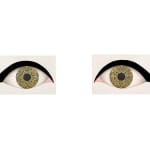Olivia Fraser
Darshan, 2019
Stone pigments, gold leaf and gum Arabic on handmade Sanganer paper
63.5 x 127 cm each
25 x 50 in each
25 x 50 in each
Further images
The word darshan means to see and be seen by the deity. It is a fundamental concept within Hindu worship where there is an active engagement between image and viewer....
The word darshan means to see and be seen by the deity. It is a fundamental concept within Hindu worship where there is an active engagement between image and viewer. What John Berger calls “the reciprocal nature of vision” is here literally translated to the physical attributes of eyes. In Indian sacred art, eyes, whether in sculpted bronze effigies of gods, painted images of folk deities on cloth temples called phads, or in pichwais - cloth backdrops painted in the traditional miniature painting style to celebrate Krishna in his child avatar as Srinathji for the Nathdwara temple in Rajasthan, the eyes are always the final element added to the icon. And once there the image is said to transform into the God and devotees can then come, lock eyes with the image and perform darshan.
There is a wonderful poem by the Cth Tamil poet, Nammalvar:
Lotus-eyed
He is in my eyes,
I see him now,
For his eyes cleanse my sight,
And all 5 senses are his bodies
Over the years I keep returning to eyes as I am fascinated by the idea within yoga of a vision within, a whole landscape within, the lotus within.
There is a wonderful poem by the Cth Tamil poet, Nammalvar:
Lotus-eyed
He is in my eyes,
I see him now,
For his eyes cleanse my sight,
And all 5 senses are his bodies
Over the years I keep returning to eyes as I am fascinated by the idea within yoga of a vision within, a whole landscape within, the lotus within.
Exhibitions
Abu Dhabi Art, UAE, Grosvenor Gallery, November 2019South Asian Art: 1820 - 2020, Asian Art in London, 22 -29 October 2020, Grosvenor Gallery, London, No. 39, illust. exh. cat. pp. 68-69
Redfern Gallery, London, Eileen Agar, 2021
1
of
4







